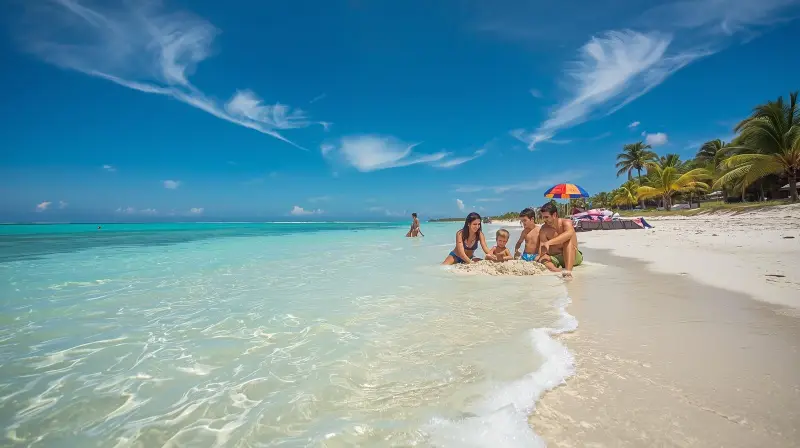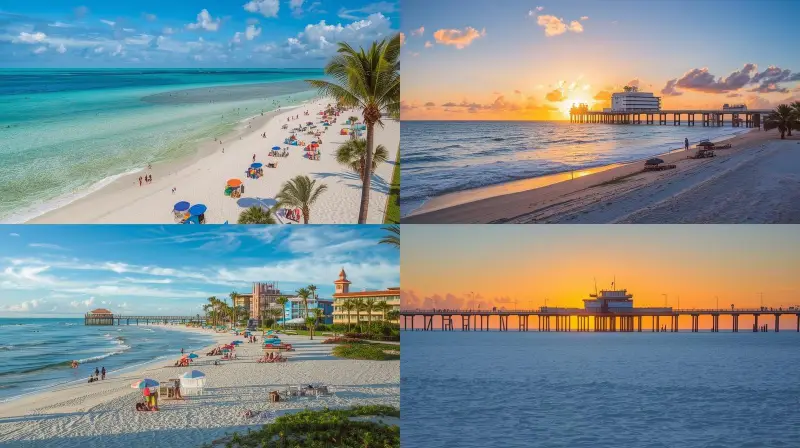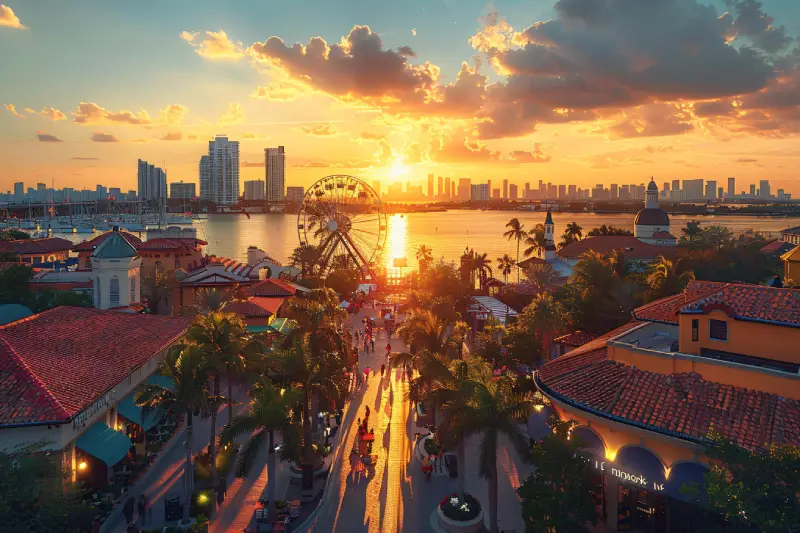How to Get to Key West: By Land, Sea & Air
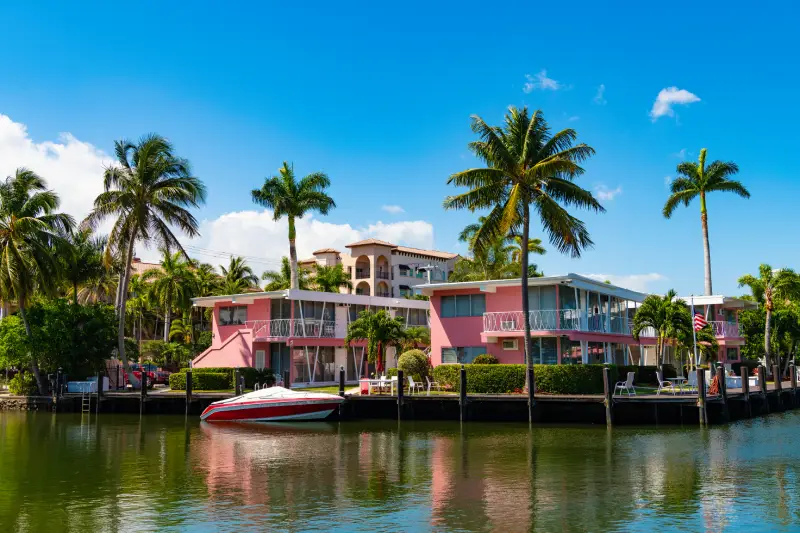
Table of Contents
ToggleWhen planning a vacation, figuring out how to get there is just as important as deciding where to go. The journey plays a crucial role in building anticipation, setting the mood, and it can even become a highlight of the trip. This is especially true when your destination is Key West, a sunny paradise at the very tip of the Florida Keys.
Getting to Key West is an experience in itself, with routes that are as unique as the island’s welcoming charm. Maybe you’ll drive the legendary Overseas Highway, a ribbon of road surrounded by endless ocean views. Perhaps you’ll hop on a ferry, skimming across turquoise waters as the island slowly comes into view. Or you might board a flight that treats you to breathtaking aerial glimpses of the Florida Keys.
No matter which path you choose, the journey to Key West promises its own magic. Before you dive into the island’s vibrant culture and tropical beauty, let’s explore the best ways to get there by land, sea, and air.
A Little Overview of Key West
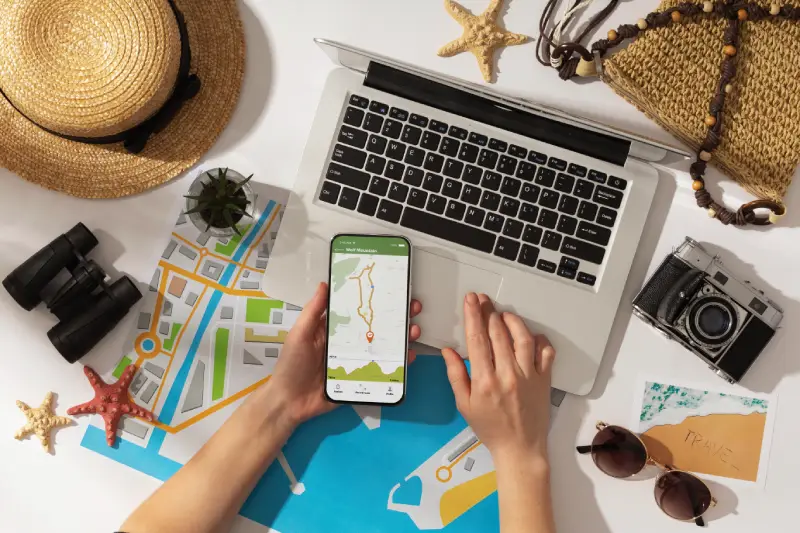
Key West is part of the Florida Keys, a chain of tropical islands stretching over 113 miles from the southern tip of Florida’s mainland. Connected by the Overseas Highway, the Keys are renowned for their natural beauty, crystal-clear waters, and opportunities for adventure like snorkeling, fishing, and boating.
Key West, the last stop in the archipelago, is only 90 miles from Cuba. Its unique blend of cultures and laid-back lifestyle attract visitors year-round. While it’s remote enough to feel like an escape, it’s surprisingly accessible by car, boat, or plane. So let’s explore how you can make your way to this sunny haven.
Getting to Key West by Land

Driving to Key West is like stepping into a moving postcard, where every mile unfolds a new scene of ocean vistas, charming island communities, and tropical splendor. The drive down the Overseas Highway, also known as US Route 1, is an adventure in itself as it’s one of the most scenic road trips in the United States.
The Overseas Highway: A Road Trip to Remember
Often referred to as the “Highway That Goes to Sea,” the Overseas Highway connects the Florida mainland to Key West via a series of islands and bridges, 42 of them in total. The most famous of these is the Seven Mile Bridge, an architectural marvel where the sea and sky seem to stretch endlessly around you. Cruising across it feels like floating between worlds.
The drive begins with Key Largo and winds its way through the Keys, offering unparalleled views of the Atlantic Ocean on one side and the Gulf of Mexico on the other. The pace is slow, with speed limits ranging between 35 and 45 mph, perfect for soaking in the beauty of your surroundings.
If you truly want to immerse yourself in the experience, consider renting a convertible for the journey. The open air and sunshine add a whole new layer of magic to the trip but don’t forget the sunscreen!
Key Stops Along the Way
A drive down the Overseas Highway isn’t complete without a few well-timed stops. This isn’t a road trip to rush; the journey is peppered with experiences that add richness to your adventure.
- Key Largo: As the gateway to the Keys, Key Largo is home to John Pennekamp Coral Reef State Park, a haven for snorkeling and diving enthusiasts. Don’t have your gear? Hop aboard a glass-bottom boat tour to admire the underwater world.
- Islamorada: Known as the “Sport Fishing Capital of the World,” Islamorada is a great spot for angling or feeding the massive tarpon at Robbie’s Marina. It’s also a fantastic place to grab some conch fritters or fresh seafood by the water.
- Marathon: This central Key offers unique attractions like the Turtle Hospital, where you can learn about rescued sea turtles and their rehabilitation. For a peaceful break, stretch your legs at Sombrero Beach, one of the area’s best-kept secrets.
- Big Pine Key: Nature lovers will adore Big Pine Key, home to the adorable and endangered Key deer. These pint-sized creatures roam freely in the National Key Deer Refuge, making for a delightful detour.
Each stop adds something special to your trip, from natural wonders to quirky island culture.
Driving Tips for the Overseas Highway
Driving through the Keys is a breeze, but a little preparation can make your journey even smoother:
- Start Early: Traffic can build up during peak travel times, and the earlier you start, the more daylight you’ll have to enjoy the drive.
- Plan for Pit Stops: Build extra time into your schedule to explore attractions and savor the scenery. This drive is meant to be enjoyed at a leisurely pace.
- Rent Smart: A convertible is perfect for this trip, but if you’re not used to Florida’s sunshine, keep sunscreen, hats, and sunglasses handy.
- Be Weather-Wise: Rain can pop up unexpectedly, so check the forecast and be prepared for slick roads.
- Pack Light: Once in Key West, you won’t need your car much if you’re staying in Old Town. Many visitors opt to return their rental car at the airport and explore the island on foot, by bicycle, or with a scooter.
Getting to Key West by Sea
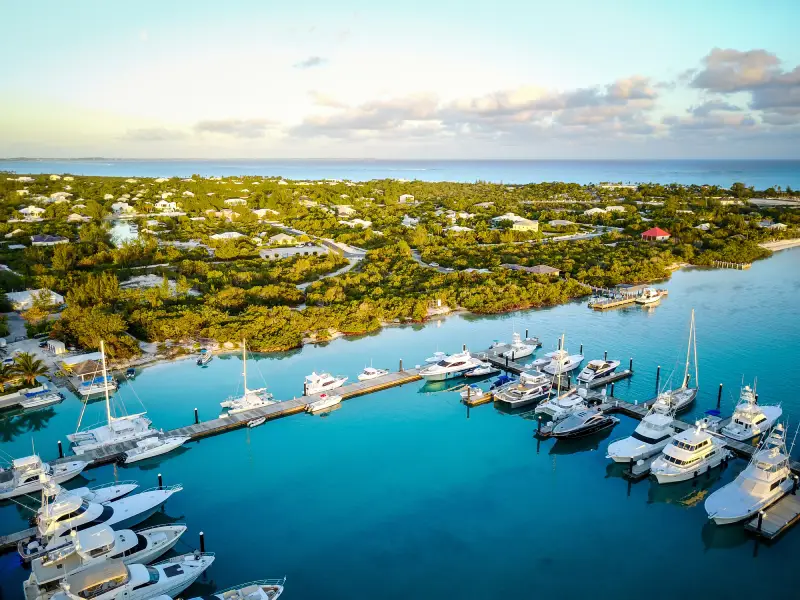
Getting to Key West by Land
Driving to Key West is like stepping into a moving postcard, where every mile unfolds a new scene of ocean vistas, charming island communities, and tropical splendor. The drive down the Overseas Highway, also known as US Route 1, is an adventure in itself as it’s one of the most scenic road trips in the United States.
The Overseas Highway: A Road Trip to Remember
Often referred to as the “Highway That Goes to Sea,” the Overseas Highway connects the Florida mainland to Key West via a series of islands and bridges, 42 of them in total. The most famous of these is the Seven Mile Bridge, an architectural marvel where the sea and sky seem to stretch endlessly around you. Cruising across it feels like floating between worlds.
The drive begins with Key Largo and winds its way through the Keys, offering unparalleled views of the Atlantic Ocean on one side and the Gulf of Mexico on the other. The pace is slow, with speed limits ranging between 35 and 45 mph, perfect for soaking in the beauty of your surroundings.
If you truly want to immerse yourself in the experience, consider renting a convertible for the journey. The open air and sunshine add a whole new layer of magic to the trip but don’t forget the sunscreen!
Key Stops Along the Way
A drive down the Overseas Highway isn’t complete without a few well-timed stops. This isn’t a road trip to rush; the journey is peppered with experiences that add richness to your adventure.
- Key Largo: As the gateway to the Keys, Key Largo is home to John Pennekamp Coral Reef State Park, a haven for snorkeling and diving enthusiasts. Don’t have your gear? Hop aboard a glass-bottom boat tour to admire the underwater world.
- Islamorada: Known as the “Sport Fishing Capital of the World,” Islamorada is a great spot for angling or feeding the massive tarpon at Robbie’s Marina. It’s also a fantastic place to grab some conch fritters or fresh seafood by the water.
- Marathon: This central Key offers unique attractions like the Turtle Hospital, where you can learn about rescued sea turtles and their rehabilitation. For a peaceful break, stretch your legs at Sombrero Beach, one of the area’s best-kept secrets.
- Big Pine Key: Nature lovers will adore Big Pine Key, home to the adorable and endangered Key deer. These pint-sized creatures roam freely in the National Key Deer Refuge, making for a delightful detour.
Each stop adds something special to your trip, from natural wonders to quirky island culture.
Driving Tips for the Overseas Highway
Driving through the Keys is a breeze, but a little preparation can make your journey even smoother:
- Start Early: Traffic can build up during peak travel times, and the earlier you start, the more daylight you’ll have to enjoy the drive.
- Plan for Pit Stops: Build extra time into your schedule to explore attractions and savor the scenery. This drive is meant to be enjoyed at a leisurely pace.
- Rent Smart: A convertible is perfect for this trip, but if you’re not used to Florida’s sunshine, keep sunscreen, hats, and sunglasses handy.
- Be Weather-Wise: Rain can pop up unexpectedly, so check the forecast and be prepared for slick roads.
- Pack Light: Once in Key West, you won’t need your car much if you’re staying in Old Town. Many visitors opt to return their rental car at the airport and explore the island on foot, by bicycle, or with a scooter.
Getting to Key West by Sea
For centuries, Key West originally known as Cayo Hueso or “Bone Island” was accessible only by sea. Long before modern tourism, the island served as a fishing outpost for Caribbean natives and a stopover for explorers, traders, and pirates navigating the waters of the Gulf of Mexico. Today, the tradition of arriving by sea continues, but with far more comfort and convenience.
By Ferry
For travelers starting on Florida’s Gulf Coast, the Key West Express ferry is one of the most popular ways to reach the island. Departing from Fort Myers Beach and Marco Island, this high-speed service combines convenience with stunning coastal views, making the journey as memorable as the destination.
What to Expect Aboard the Ferry
The Key West Express operates modern vessels designed for both comfort and entertainment. Whether you’re inside the air-conditioned cabin or enjoying the sun deck, you’ll have everything you need for a pleasant trip:
- Comfortable Seating: Spacious interiors with cushioned seating and panoramic windows.
- Amenities: A full-service bar, a galley offering snacks and meals, large flat-screen TVs with satellite programming, and knowledgeable crews with years of experience.
- Travel Time: The ferry takes approximately 3.5 to 4 hours to reach Key West.
- Arrival Location: The ferry docks at the Key West Historic Seaport, just a short stroll from Duval Street, Mallory Square, and other central attractions.
Tips for Ferry Travel
- Book Early: The ferry is a favorite among visitors, especially during peak travel times, so secure your tickets in advance.
- Pack Light: Space is limited, so bring only essentials for the journey.
- Arrive Early: Plan to be at the dock at least an hour before departure to ensure a smooth boarding process.
- Relax and Enjoy: Bring sunscreen if you plan to spend time on the sun deck and savor the views as you glide toward paradise.
By Private Boat or Yacht
If you’re lucky enough to own your own vessel, arriving in Key West by boat is a thrilling experience. Navigating the waters of the Gulf of Mexico or the Atlantic Ocean and pulling into one of the island’s many marinas is the epitome of nautical adventure.
Top Marinas in Key West
Key West offers several well-equipped marinas, each catering to a range of vessel sizes and needs:
- Key West Bight Marina: Situated near the lively Historic Seaport, this marina is ideal for large yachts and provides easy access to local restaurants and attractions.
- Westin Key West Marina: Featuring 37 slips that accommodate vessels from 25 to 200 feet, this marina offers water and electric hookups for a hassle-free stay.
- Oceanside Marina: With 96 slips ranging from 40 to 80 feet, this marina caters to larger boats and offers convenient access to the open ocean.
- Sunset Marina: Located near the Gulf of Mexico, Sunset Marina offers slips up to 60 feet, making it a favorite for mid-sized boats.
- Conch Harbor Marina: This marina provides annual, monthly, and transient dockage options, ideal for flexible schedules.
- Garrison Bight Marina: The only dry storage facility in Key West, this marina is perfect for quick access to the Gulf, Atlantic, or the serene backcountry.
- Key West Yacht Club Marina: Located off the Atlantic shoreline, this exclusive marina offers a tranquil retreat while remaining close to the island’s bustling attractions.
Navigation Tips
- Plan Ahead: Study nautical charts and familiarize yourself with tide schedules. The waters around the Keys can be shallow, and sandbars are common.
- Check Weather Conditions: Sudden storms are not uncommon, particularly during hurricane season, so monitor the forecast and adjust your plans if necessary.
- Reserve Early: Marinas in Key West are in high demand, especially during peak seasons. Contact the dockmaster ahead of time to secure a slip.
By Cruise Ship
Key West is also a popular stop for cruise ships exploring the Caribbean and Gulf of Mexico. Major cruise lines such as Royal Caribbean, Carnival, Celebrity Cruises, Disney, and Norwegian regularly include Key West in their itineraries. European-based lines like P&O Cruises, Costa, and MSC Cruises also make stops in this tropical haven.
What to Expect as a Cruise Passenger
Most cruise ships dock at one of three locations: Mallory Square, the Outer Mole Pier, or the Navy Mole. Once ashore, visitors can take advantage of the island’s compact size and easily explore the highlights on foot, by bike, or with a guided tour.
Cruise passengers often have just a few hours to spend on the island, but that’s enough time to:
- Visit the Ernest Hemingway Home and Museum.
- Snap a photo at the Southernmost Point Buoy.
- Stroll Duval Street for shopping, dining, and live music.
- Enjoy a conch fritter or slice of Key Lime pie at a local eatery.
Getting to Key West by Air
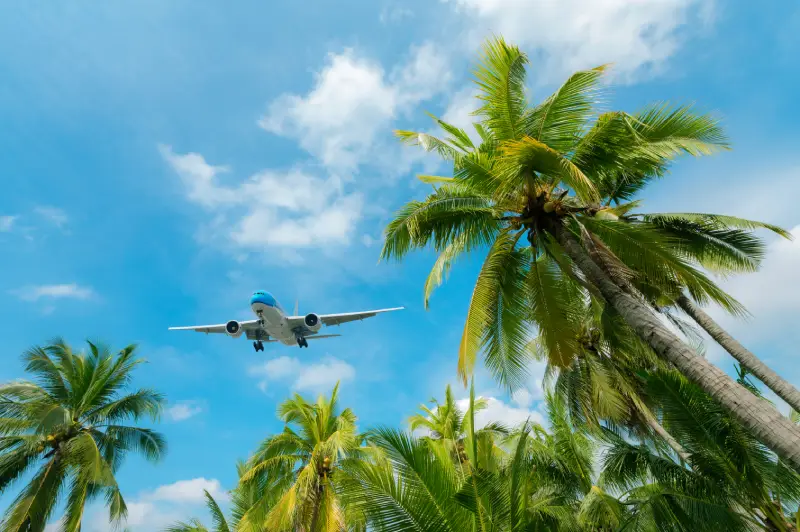
If you’re looking for the fastest and most convenient way to reach Key West, flying is obviously your best bet. With its small but efficient airport and regular flights from major U.S. cities, the Conch Republic is just a short journey away.
Key West International Airport (EYW)
Located just minutes from downtown Key West, Key West International Airport (EYW) is compact and easy to navigate. While it’s not a sprawling hub, it connects travelers from across the country, offering the perfect introduction to the island’s relaxed pace. From the moment you disembark, you’ll feel the tropical vibes with palm trees swaying in the breeze and a casual atmosphere that sets the tone for your stay.
Airlines and Direct Flights to Key West
A handful of major airlines operate daily flights to Key West, with non-stop service from a variety of cities:
- Delta Air Lines: Non-stop flights to/from Atlanta (ATL) and New York LaGuardia (LGA).
- American Airlines: Non-stop flights to/from Miami (MIA), Boston (BOS), Philadelphia (PHL), Dallas/Fort Worth (DFW), Charlotte (CLT), and Washington DC (DCA).
- United Airlines: Non-stop flights to/from Chicago O’Hare (ORD) and Newark (EWR).
- Silver Airways: Regional flights to/from Fort Lauderdale (FLL), Fort Myers (RSW), Tampa (TPA), and Orlando (MCO).
What to Expect When Flying Into EYW
Key West International Airport is designed for efficiency and ease. You won’t face the overwhelming crowds or long walks that often come with larger airports. Instead, you’ll enjoy quick transitions from landing to transportation, giving you more time to start exploring the island.
- Proximity to Downtown: The airport is just a 10-minute drive to Old Town, Key West’s historic heart.
- Compact Size: With only a few gates, it’s easy to navigate, and baggage claim is a breeze.
- Tropical Welcome: The airport’s open-air areas and island-themed decor give you an instant taste of the laid-back Key West vibe.
Tips for Flying to Key West
- Book Early: Flights to Key West are popular, especially during peak travel seasons like winter and spring. Early bookings can help secure better prices and ensure availability.
- Consider Connections: While direct flights are convenient, connecting through Miami or Fort Lauderdale can open up more options and potentially save on airfare.
- Travel Light: Plan for smaller planes with limited luggage capacity. If possible, stick to carry-on luggage to simplify your journey.
- Check Weather Forecasts: Key West’s tropical climate can occasionally cause weather delays, especially during hurricane season (June–November). Monitor forecasts and stay flexible with your plans.
- Transportation Options: Once you land, taxis, ride-shares, shuttles, and rental cars are readily available. However, keep in mind that Key West is compact and best explored on foot, by bike, or with a scooter, especially if you’re staying in Old Town.
Best Time to Travel
Timing your trip can make all the difference when it comes to getting to Key West:
- Peak Season (December to April): Ideal weather draws crowds, so plan ahead for higher prices and more traffic.
- Off-Season (May to November): Fewer tourists and lower prices make this an attractive option but be mindful of hurricane season.
- Weekdays vs. Weekends: Traveling midweek often means less congestion on the highway and lower ferry or flight fares.
Conclusion
No matter how you choose to reach Key West by land, sea, or air, the journey is an integral part of the adventure. Each option offers unique experiences, whether the thrill of driving across the Overseas Highway, the serenity of gliding across turquoise waters, or the convenience of flying directly to the island.
Key West awaits with its sunny skies, welcoming locals, and vibrant culture. So pack your bags, pick your route, and get ready for the unforgettable experience that begins long before you set foot on the island. Safe travels, and welcome to paradise!
Author
Book your fondest memory here
Popular Posts
Best Family-Friendly Beaches in Florida
With its pristine beaches and warm waters, Florida is a…
Best Beaches in Florida: From Clearwater to South Beach
Florida is a beach lover’s paradise, and that’s no exaggeration.…
Best Places to Visit in Florida During Winter
Winter is the perfect time to step away from the…
Categories
- Best Places (25)
- Destinations (26)
- Experiences (21)
- Photography (1)
- Travel (48)
- Travel Products (7)
- Trip Style (8)
Search With Tags
Join Our Newsletter
Get Your Daily
Dose
Of Travel Inspiration
"*" indicates required fields
